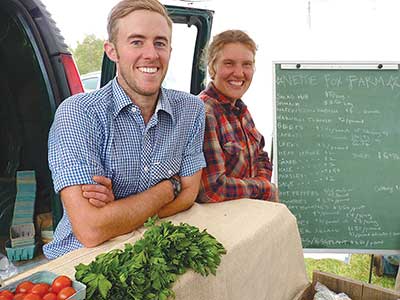 |
| Everett Ottinger and Molly Crouse of Nettie Fox Farm at the Common Ground Country Fair. English photo |
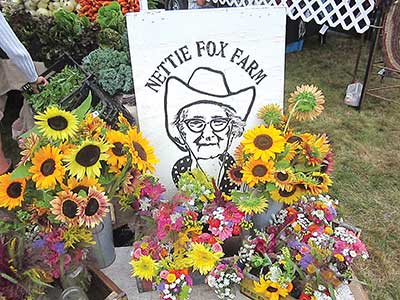 |
| Cut flowers are among the varied crops grown at Nettie Fox Farm. Photo by Molly Crouse |
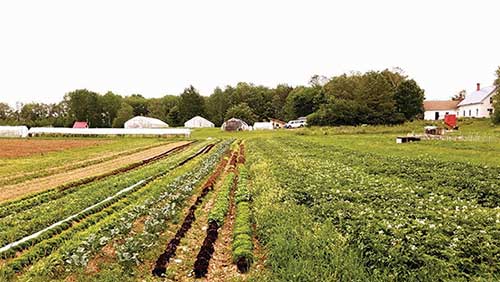 |
| View of the fields, high tunnels and farmhouse in Crouse’s hometown of Newburgh. Photo by Nick Owings |
By Sonja Heyck-Merlin
In 2009, when Molly Crouse started looking for a farm, she cruised the roads of Newburgh, Maine, her hometown. Located in Penobscot County, Newburgh is 15 miles southwest of Bangor. She also hung up a land-wanted poster at the local variety store.
A local landowner responded to the poster. Crouse learned that the land he was selling was a mile from her childhood home and that he remembered her as a child.
The 35 acres was intended to be Newburgh’s first subdivision. Crouse bought the first 25 acres with a Farm Service Agency loan. She farmed MOFGA-certified organic Nettie Fox Farm on her own until 2014, when she and Everett Ottinger joined forces.
Crouse had apprenticed at Peacemeal Farm in Dixmont, Maine, and had been a MOFGA farmer-in-residence. Ottinger had apprenticed at King Hill Farm in Penobscot, Maine, and other farms on the Blue Hill Peninsula. The pair, which started as a “blind date” as Crouse says, has since become integral to central Maine’s agricultural community.
In the seven years they have been farming together, they bought the remaining house lots and now own the 35 acres that were destined for development. Nettie Fox Farm, now with 5 acres under cultivation, is named after Crouse’s great-grandmother, who was born in New Brunswick in 1891 and moved to Aroostook County with her family in 1894.
The couple has two children, Juniper (2 1/2) and Esben (3 months). Each season they typically host two full-time MOFGA apprentices and employ a few part-time workers who help harvest. Crouse and Ottinger praise their parents, who often lend a hand any way they can.
Spring
Most vegetable farmers mark the end of winter by firing up their greenhouse – cleaning up last year’s detritus, dusting off the heat mats and igniting the woodstove, oil or propane heater. This was the spring routine at Nettie Fox until three years ago when the farmers needed extra greenhouse capacity. They sent their overflow to the greenhouse at MOFGA-certified organic Mckay Farm (owned by Unity College) and were pleased with the results.
For the past two years, they have shifted most of their greenhouse propagation to the Mckay Farm, which rents space by the table. “The price of renting space is only slightly higher than the price of fuel,” Ottinger says. “On top of that, it’s a state-of-the-art greenhouse, you don’t have to worry about watering, or lie awake in the middle of the night worrying that the wind is about to destroy your greenhouse. Really, the only drawback is the commute.”
At the end of May, when most seedlings have been transplanted, they bring home and harden off any remaining plants. For the rest of the season, successional plantings of seedlings occur in an on-farm 10-by-12-foot plastic structure.
The couple has two 100-by-12-foot homemade caterpillar tunnels as well as two Ledgewood hoophouses, one 26 by 48 and one 26 by 96 feet. They cultivate in the caterpillars and high tunnels by hand, with digging forks and a broad fork.
Around St. Patrick’s Day they plant caterpillars and high tunnels with crops for the early spring market – Salanova lettuce, spinach, chard, carrots, beets, salad turnips and sugar snap peas. Historically, Crouse has used a Planet Junior seeder for direct-seeded crops, but she is experimenting with a Jang seeder as well. “The Jang is more precise, which means less thinning. I also think it does a better job than the Planet Junior at getting seed-to-soil contact,” she says.
Spring tillage begins as soon as soil conditions allow. They grow vegetable crops on roughly 3 1/2 of their 5 cultivated acres each season. Most of their fields are either 220 by 200 feet or 100 by 100 feet. Their primary pieces of tillage equipment – a two-bottom plow, three-point-hitch disc harrow and a Ferguson SKO-20 cultivator – are pulled behind a 1986 Ford 2110 FWD tractor. Ottinger says that when the Ferguson dies, they’ll get a Fred Cain cultivator. He also appreciates their John Deere Van Brunt grain drill, which paid for itself in cover crop seed in 1 1/2 seasons.
For new fields or fields planted in perennial cover crops, Crouse and Ottinger use all three pieces of tillage equipment in succession. When possible, however, they avoid using the plow to minimize plow pan development.
If a field has plant residue from the prior season or a winter-killed cover crop, they prefer to combine the harrow and Ferguson to prepare the soil for seeding and transplanting. Ottinger says, “If a field is heavy in plant matter, we will disc first, let it break down some, and then follow with the Ferguson. I also have used the Ferguson as the first thing on a field that was bare through the winter. I can work up a field in way fewer passes than the plow and still have very workable soil.”
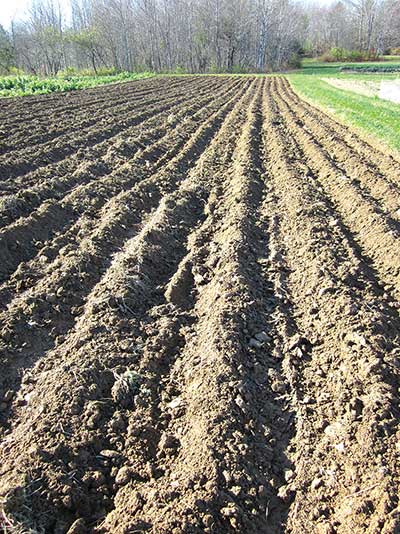 |
| Ottinger and Crouse hope that planting in ridges will make weed control more efficient. Photo by Molly Crouse |
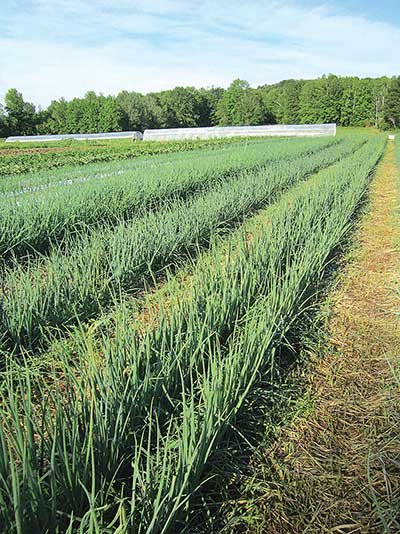 |
| Storage onions growing in beds. Photo by Molly Crouse |
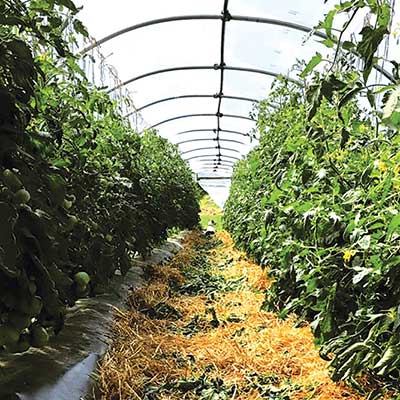 |
| Tomatoes and some other warm-season crops grow in high tunnels in the summer. Photo by Molly Crouse |
Because of significant weed pressure, which the couple identifies as one of its greatest challenges, they recently shifted from 3-foot-wide beds with 16-inch-wide paths to rows on elevated ridges 24 inches on center. They form the ridges with a the Cub and a modified hilling disc implement. The use the ridge system for transplanting and direct seeding everything that is not on plastic mulch. It has been easier to cultivate, with more room between rows for passes with duck feet on Danish S-Tines on the Cub toolbar for paths, 7-inch scuffles for shoulders of the ridge, and with a Hoss high-arch double-wheel hoe with scuffle hoe attachments for up close. They can cover three ridges per length of row cover over wire hoops in a “McDonalds arch” configuration. Winds preclude covering more than three ridges. The farmers transitioned from buried row cover edges to weight bags.
Ottinger says, “We don’t have a rototiller by design.” Having both worked on farms that relied heavily on rototillers, he says, “We prefer a chunkier, high-residue soil for moisture retention, especially as we switch to the ridge system. Chunkier soil will be better than powdered sugar for forming the ridges.”
Summer
When the spring high tunnel and caterpillar crops are finished, the houses grow summer crops – tomatoes, peppers, pole beans, basil, cucumbers and ginger this year.
Storage onions, solanaceous crops, flowers, cucurbits and sweet potatoes grow in plastic mulch on 36-inch beds in the field. Crouse and Ottinger abandoned their Buckeye plastic mulch layer and now lay the plastic by hand.
“We would love to be at the point where we’re on top of the weed and labor situation enough to eliminate the plastic mulch, but we’re not there yet,” the pair says.
They also rely heavily on floating row cover for most crops. Ottinger says they transitioned to AgroFabric because it doesn’t rip right off the roll. “We have AgroFabric that’s four years old.”
In past years, Crouse and Ottinger rotationally grazed five or six feeder sheep on resting fields to bolster fertility. “Once we don’t have two tiny children, we want to add that back. Eventually, we would like to close the fertility loop,” Crouse says. Meanwhile they depend on fertilizer spread at rates recommended by their University of Maine soil tests. Former corn ground, their sandy soils (primarily Dixmont loam) are high in phosphorus. Their primary fertilizer is an organic 10-2-8 blend, spread with a ground-driven fertilizer attachment on the Cub.
Historically Nettie Fox belonged to farmers’ markets in Brewer, downtown Bangor and Northeast Harbor. In 2018, however, they dropped Northeast Harbor to eliminate a long commute and hoping to reduce their labor demand. In reality, the decrease in sales far exceeded the amount they saved in labor, so they picked up the Hampden market for the 2019 season.
They also have 55 CSA members (half and full shares). Also, 30 debit card holders prepay a $100 minimum to receive 8 percent off market price. There is no maximum.
Crouse recognizes that the diversified organic vegetable farm is not a unique model. Asked how Nettie Fox distinguishes itself in the marketplace, she says, “I love going to market. The one-on-one contact is what sets us apart. We are lucky to have an extremely loyal customer base. We capitalize on customer service and want people to feel like they are part of our family. Also, we always make sure we have a consistent quality product. We are sticklers for quality.”
Diversity is also an important marketing tool. While the couple acknowledges the importance of calculating the costs associated with a particular crop, at this point they are not willing to eliminate a crop based on those figures.
“If you’re just looking at the dollar earned, you’re missing the big picture,” Ottinger says. “Part of what we sell is the fact that we have a lot of diversity. For us, a loss leader crop like potatoes will get people interested in our stand. They will buy the potatoes, but then they also buy a bag of spinach and carrots.”
Pastured poultry provides about 10 percent of their gross farm sales. They raise about 300 Kosher Kings a year in batches of 50, moved twice daily in homemade chicken tractors. In addition to adding diversity, the pair credits the birds for “doing some great work for us by adding fertility and keeping bug populations in check.”
In 2018 the birds rotationally grazed an out-of-rotation vegetable field that had been seeded to clover the prior year. This year they planned to plant winter squash in strips tilled in the clover, taking advantage of fertility from the poultry and weed suppression by the clover.
Fall
The transition from summer to fall is marked by curing onions, garlic and winter squash, cover cropping sections of field and digging root crops. Each year about 1 1/2 acres are in cover crops and out of production. Their most common and most economical cover crop strategy is planting peas and oats that winterkill, followed by high-density plantings of buckwheat the following season and then a fall planting of peas and oats to stabilize the soil over the winter. About a quarter of the rested ground is planted to clover.
Fall is also marked by preparations for the Common Ground Country Fair. Since 2011 Nettie Fox has been in the farmers’ market at the south (rose) gate. “We love the Fair,” Crouse says. “It’s the peak of our farming season, and we look forward to it all summer. It also marks the winding down of the season as far as pace goes.”
The Fair provides a similar income each year, although Crouse says customer tastes have changed over time. “We still have some bulk buyers, but customers seem more interested in things like garlic braids, salad mix and snackable items like carrot bunches.” Their garlic braids, decorated with statice, straw and gomphrena flowers and ornamental grasses, are very popular.
Through experience and fine tuning, “the week of the Fair gets more and more chill and more fun every year,” Crouse says. “It’s a lovely time of year; beautiful, frosty, and the closing of the season.”
Winter
Crouse and Ottinger’s ultimate goal is for the farm to support them financially for the whole year, but both have typically maintained part-time winters jobs – Crouse at Fedco Seeds and Ottinger at Winter’s End Brick and Stonework. Winter work has become difficult since starting a family and being dealt a serious, unforeseen project.
In November of 2017 the family had to move out of its farmhouse, built in 1861, due to lead contamination. Daughter Juniper’s lead levels were elevated beyond the normal threshold. The couple conjectures that the contamination was caused primarily by lead dust that originated from old windows and scraping before an exterior paint job in 2015. “We knew there was lead paint in the house,” Crouse explains, “but we didn’t understand the lead dust aspect, and I don’t think many people do.”
They moved in with Crouse’s family for the winter of 2017 and then lived in their apprentice housing until May of 2019. Ottinger spent the past winter renovating and remediating one room at a time. Although they are back in their house and the lead levels are considered safe, Ottinger says, “Not every room is done and some is still closed off. It’s not done by a long shot.”
Between their normal farming routine, the house renovation, and raising two young children, the past year and a half have been markedly stressful.
The Year Ahead
Crouse and Ottinger hope that the 2019 growing season will be more typical, although the cool, wet conditions had challenged that early in the season. With a third farmers’ market and two apprentices, the couple hopes to gross $25,000 to $30,000 per acre, numbers they have achieved in the past and that are necessary to reinvest in their business.
“Our two biggest areas that we need to catch up with in terms of infrastructure are irrigation and our postharvest system,” Ottinger says. “Currently we are running drip tape header from our household well pump into a tangled spiderweb of plastic. We need to put in some permanent irrigation lines. And we have totally outgrown our current wash, pack and storage system.” If all goes as planned in 2019, they hope to have $5,000 to begin investing in these projects.
The Nettie Fox ecosystem – now a diversity of cultivated and wild plants, domestic and wild creatures, water, soil, sun, microbes and people – could easily have been consumed by the suburban sprawl radiating from Bangor. Fortunately what could have been Newburgh’s first subdivision is now a thriving organic farm built on family, community and biodiversity.
About the author: Sonja and her family own and operate an organic dairy farm in Charleston, Maine.
